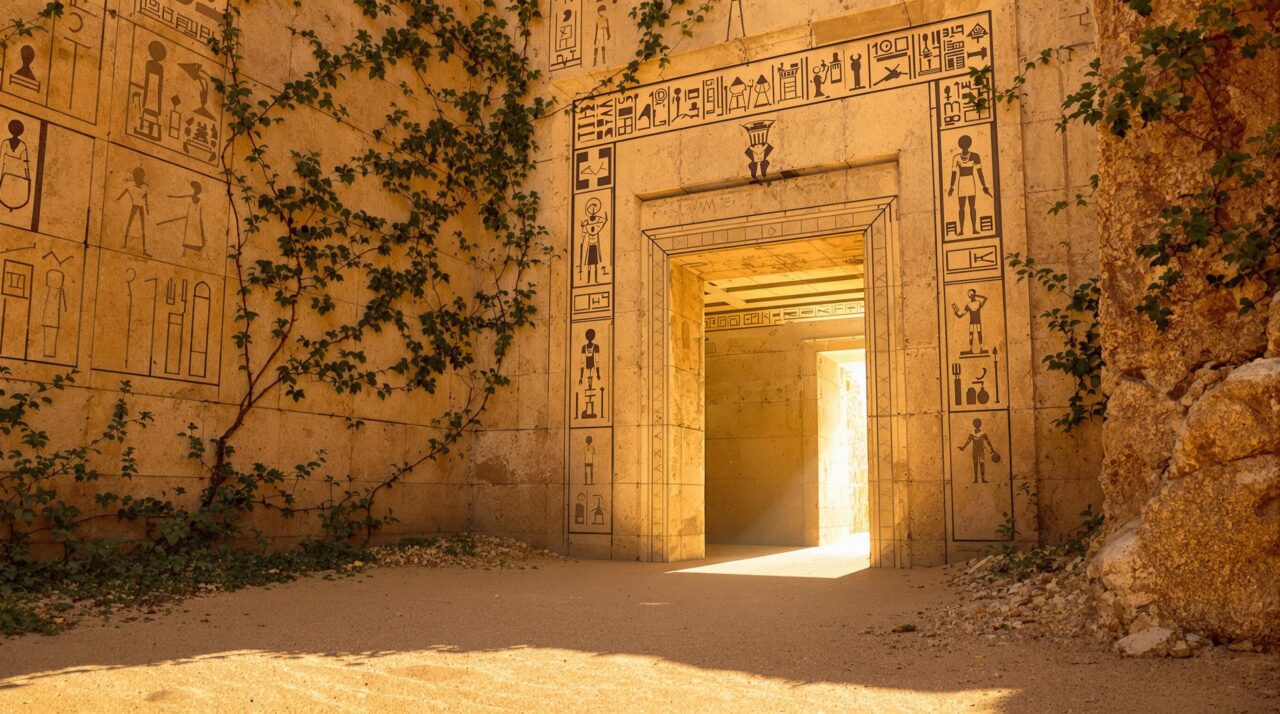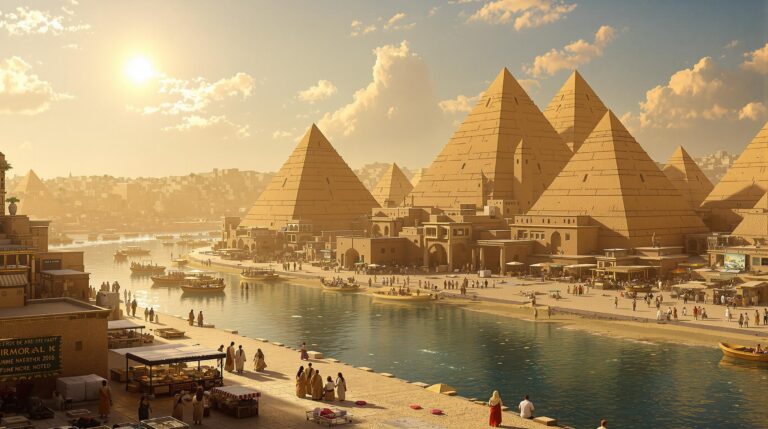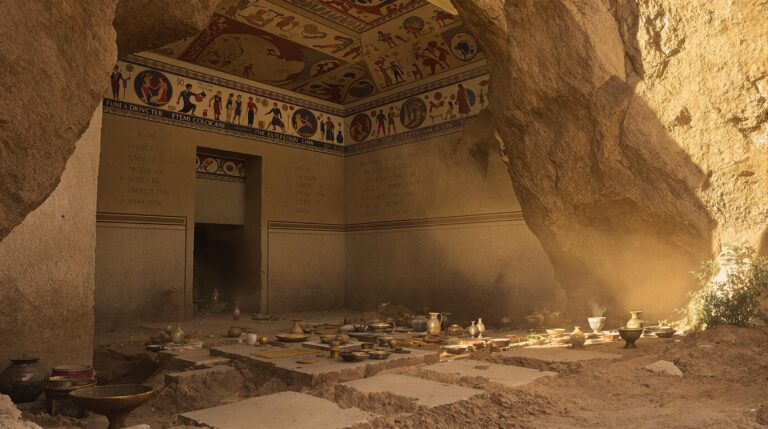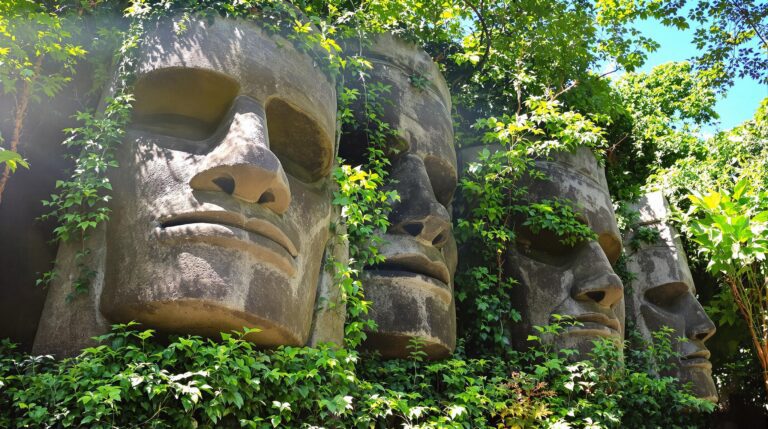Lost Tomb of Cleopatra

The lost tomb of Cleopatra remains a tantalizing enigma. Scholars and archaeologists have pursued its location for centuries, guided by ancient texts and local lore.
Yet, these clues often contradict each other, complicating the search. Recent advancements in technology offer new hope, but the question persists: what lies beneath the sands of time?
As efforts intensify, the implications of such a discovery could profoundly alter our understanding of Cleopatra and her era.
TL;DR
Hide- Cleopatra's burial site remains a mystery, with conflicting ancient accounts complicating its historical interpretation and location.
- Folklore and local legends suggest hidden chambers and sacred sites connected to Cleopatra's legacy, blurring historical facts with myth.
- Expeditions in the 19th and 20th centuries fueled interest in her tomb, driven by fame, academic curiosity, and romantic notions of discovery.
- Modern excavation technologies, such as ground-penetrating radar, are enhancing the search for Cleopatra's tomb, focusing on promising sites like Taposiris Magna.
- The quest for Cleopatra's tomb symbolizes humanity's enduring desire to uncover the past and connect with ancient cultural heritage.
Lost Tomb of Cleopatra Context: Cleopatra’s Enduring Influence and Final Days
Cleopatra, often referred to as the Last Pharaoh of Egypt, remains a figure shrouded in both historical significance and mystery, especially regarding her final days and burial.
What factors contributed to her lasting influence on culture and politics, and how have they shaped perceptions of her life and death?
The quest to uncover the location of her tomb adds another layer of intrigue to her enigmatic legacy.
Cleopatra: The Last Pharaoh of Egypt
As the last pharaoh of Egypt, Cleopatra’s political alliances and personal charisma shaped not only her reign but also the fate of her kingdom.
How did her relationships with powerful figures like Julius Caesar and Mark Antony influence her legacy?
Additionally, what enduring impact did her life and rule leave on history, transcending the borders of her time?
Political Alliances and Personal Charisma
While the allure of Cleopatra as a historical figure often evokes images of beauty and seduction, her true power lay in her exceptional ability to forge political alliances and wield personal charisma.
How did her relationships with powerful figures like Julius Caesar and Mark Antony shape her reign? Cleopatra’s skillful diplomacy showcased her intelligence, ensuring Egypt’s prominence in a tumultuous political landscape.
Legacy Beyond Her Reign
Although often overshadowed by her dramatic life and tragic end, Cleopatra’s legacy extends far beyond her reign as the last Pharaoh of Egypt.
Her influence persists in various domains:
- Cultural depictions in literature and film
- Feminist icon representing female agency
- Innovations in political strategy
- Symbol of ancient Egypt’s grandeur
- Inspiration for modern leaders and thinkers
Her story continues to captivate and inspire exploration.
Mystery Surrounding Her Burial
The circumstances surrounding Cleopatra’s burial remain shrouded in uncertainty, with ancient accounts often conflicting with contemporary interpretations.
Scholars continue to grapple with theories regarding the location of her tomb, igniting debates that bridge history and archaeology.
What insights can these discussions provide about not only Cleopatra’s final days but also her lasting legacy?
Ancient Accounts vs. Modern Perceptions
What drives the fascination with Cleopatra’s final days and the mystery surrounding her burial?
Ancient narratives and modern interpretations intersect, revealing layers of intrigue.
Consider the following aspects:
- Cleopatra’s portrayal in Roman literature
- The symbolism of her relationship with Mark Antony
- The political implications of her death
- The allure of her legendary beauty
- The ongoing quest for her lost tomb
These elements fuel enduring curiosity.
Debate Over the Tomb’s Possible Location
Where might Cleopatra’s final resting place lie, and why does its elusive nature captivate historians and archaeologists alike?
Theories abound, ranging from Alexandria’s submerged structures to undiscovered sites in Egypt’s western desert. Each proposition invites scrutiny, revealing layers of historical significance and cultural symbolism.
As experts debate, the search for Cleopatra’s tomb continues to symbolize humanity’s quest for understanding its enigmatic past.
Historical Clues: Writers and Local Traditions
The historical writings of figures like Plutarch offer intriguing insights into Cleopatra’s life and death, yet they also raise questions about the accuracy and reliability of ancient accounts.
Local folklore and legends further complicate the narrative, suggesting that the tomb’s location may be intertwined with cultural memory and myth.
How do these diverse sources shape our understanding of Cleopatra’s final resting place, and what can they reveal about the historical context of her time?
Plutarch and Other Classical Sources
Ancient texts, particularly those by Plutarch, offer intriguing yet often ambiguous clues about Cleopatra’s final resting place.
These historical records frequently present contradictions and gaps, challenging scholars to piece together a coherent narrative from fragmented information.
What can be gleaned from these classical sources, and how might local traditions further illuminate the mystery surrounding the lost tomb?
Possible Hints in Ancient Texts
What secrets might lie hidden within the texts of antiquity, waiting to be uncovered in the search for Cleopatra’s lost tomb?
Scholars examine ancient writings for clues about her burial site, focusing on:
- Plutarch’s accounts of her life and death
- Local legends from Alexandria
- References to tombs in Hellenistic literature
- Descriptions of royal funerary practices
- Geographic markers in classical texts
These elements may illuminate her final resting place.
Contradictions and Gaps in Historical Records
Amid the search for Cleopatra’s lost tomb, the reliability of historical records becomes a pivotal concern.
Plutarch and other classical sources provide tantalizing insights, yet contradictions and gaps abound.
These inconsistencies raise questions: How accurately did ancient writers capture events? What local traditions might have influenced their narratives?
Such inquiries challenge scholars to piece together a coherent understanding of Cleopatra’s final resting place amidst the fragments of history.
Folklore and Local Legends
Folklore surrounding Cleopatra’s lost tomb offers a vibrant mosaic of narratives that have been woven through generations.
These local legends often blur the lines between myth and historical fact, raising questions about their origins and authenticity.
Analyzing these stories could reveal not only the cultural significance of Cleopatra’s legacy but also potential clues about the tomb’s true location.
Stories Passed Down Through Generations
Although historical records regarding Cleopatra’s final resting place are scarce, stories passed down through generations provide intriguing clues that spark curiosity about her lost tomb.
These narratives often intertwine history with myth, revealing cultural insights and local traditions:
- Ancient texts hinting at hidden chambers
- Folklore about sacred sites
- Local legends of treasure
- Accounts of secretive rituals
- Oral traditions celebrating her legacy
Each contributes to the enigma surrounding her disappearance.
Separating Myth from Evidence
How can one differentiate between the enduring myths surrounding Cleopatra’s final resting place and the historical evidence that supports them?
By examining ancient texts, local traditions, and folklore, scholars can unearth clues that either substantiate or refute these legends.
The task lies in critically evaluating the sources, discerning fact from fiction, and understanding how cultural narratives shape perceptions of history, especially regarding Cleopatra’s enigmatic tomb.
Early Searches for Cleopatra’s Resting Place
The quest for Cleopatra’s final resting place captivated explorers throughout the 19th and 20th centuries, prompting numerous expeditions into the sands of Egypt.
However, these searches often faced formidable challenges, including limited funding and the complex political landscapes of their times.
What drove these adventurers, and how did their efforts shape our understanding of Cleopatra’s legacy?
Explorers of the 19th and 20th Centuries
The 19th and 20th centuries witnessed a surge of interest in Cleopatra’s elusive resting place, driven by both romantic notions and scholarly pursuits.
Explorers were often motivated by the allure of uncovering lost artifacts and deciphering ancient maps that hinted at her burial site. This quest not only reflected their personal ambitions but also a broader fascination with Egypt’s storied past, prompting questions about the intersection of myth and history.
Motivations Behind Their Expeditions
Amidst the allure of ancient mysteries and the enduring legacy of one of history’s most enigmatic figures, explorers of the 19th and 20th centuries commenced on expeditions driven by a fervent desire to uncover Cleopatra’s final resting place.
Their motivations included:
- A quest for fame and recognition
- The promise of untold riches
- Academic curiosity
- Cultural heritage preservation
- A yearning for adventure and discovery
Artifacts and Maps That Spurred Interest
Driven by their ambitions and curiosity, explorers of the 19th and 20th centuries were often guided by artifacts and maps believed to hold clues to Cleopatra’s burial site.
These relics, steeped in history, ignited imaginations and spurred relentless quests. Each map, each fragment, offered tantalizing hints, leaving explorers to ponder: could these traces lead to the lost queen’s eternal resting place?
Funding and Political Challenges
The search for Cleopatra’s tomb has often been impeded by shifting government agendas and the fluctuating priorities of funding bodies.
How have these external pressures influenced archaeological pursuits and the allocation of resources?
Understanding the interplay between political interests and exploratory endeavors reveals a complex landscape that has shaped the quest for this iconic historical figure.
Changing Government Agendas
As political climates shifted throughout the decades, the pursuit of Cleopatra’s final resting place became entangled in the ambitions of various governments.
Funding often depended on:
- National pride and cultural heritage.
- Shifts in archaeological interests.
- Diplomatic relations with Egypt.
- Economic conditions and budgetary constraints.
- Public interest and media influence.
These factors illuminated the complex interplay between archaeology and politics, raising questions about the true motivations behind the searches.
Impact of Conflicting Priorities
While the allure of Cleopatra’s lost tomb captivated many, the early searches faced significant hurdles stemming from conflicting priorities among funding sources and political entities.
Archaeological endeavors often competed for limited resources, with national interests overshadowing historical pursuits.
Political instability compounded these challenges, leaving researchers to navigate a complex landscape where passion for discovery clashed with bureaucratic constraints, ultimately stalling progress in uncovering the queen’s final resting place.
Modern Excavations and Archaeological Methods
Recent advancements in radar and remote sensing technology have transformed the approach to locating Cleopatra’s tomb, allowing archaeologists to explore previously inaccessible areas of Alexandria.
These innovative methods not only enhance the precision of excavation efforts but also raise questions about the potential sites that may harbor this historic burial.
What revelations might these modern techniques uncover about the hidden legacy of one of history’s most enigmatic figures?
Use of Radar and Remote Sensing
The application of radar and remote sensing technologies in modern archaeology raises intriguing questions about their efficacy in mapping subterranean structures.
Could these advanced methods reveal previously hidden ruins that hold the key to understanding Cleopatra’s final resting place?
As researchers harness these tools, the potential for groundbreaking discoveries looms large, challenging traditional excavation practices.
Mapping Subterranean Structures
Archaeologists stand poised at the threshold of ancient mysteries, armed with cutting-edge technology to explore subterranean structures beneath the sands of Egypt.
Their techniques raise compelling questions about what lies hidden below the surface.
- Ground-penetrating radar (GPR) effectiveness
- Electromagnetic surveys for site detection
- 3D imaging of ancient architectures
- Non-invasive excavation strategies
- Historical context integration with data analysis
Uncovering Previously Hidden Ruins
Innovative archaeological methods are revolutionizing the exploration of previously hidden ruins, particularly in regions steeped in history like Egypt.
Techniques such as ground-penetrating radar and remote sensing allow researchers to visualize ancient structures without invasive digging.
These advancements provoke questions about the extent of undiscovered sites, igniting curiosity and fostering a deeper understanding of historical narratives while encouraging a respect for the past’s hidden depths.
Key Excavation Sites in Alexandria
The search for Cleopatra’s lost tomb has led archaeologists to key sites in Alexandria, particularly Taposiris Magna, which has emerged as a strong candidate.
Ongoing efforts utilize advanced techniques to refine the locations of potential burial sites, raising questions about the historical context and significance of these findings.
What methods and technologies are being employed to guarantee that these excavations yield fruitful results in this quest for one of history’s most enigmatic figures?
Taposiris Magna and Other Candidate Locations
Taposiris Magna, a site steeped in mystery and history, has emerged as a focal point in the search for Cleopatra’s final resting place. Archaeologists are captivated by its potential, alongside other candidate locations.
Key factors fueling this intrigue include:
- Ancient inscriptions
- Unique burial practices
- Proximity to Alexandria
- Architectural significance
- Ongoing research initiatives
Each element adds layers to the quest for understanding Cleopatra’s legacy.
Ongoing Efforts to Pinpoint the Tomb
Numerous modern excavations are currently underway in Alexandria, each employing cutting-edge archaeological methods to uncover clues that may lead to Cleopatra’s elusive tomb.
Researchers utilize ground-penetrating radar and advanced imaging techniques to navigate the complex layers of history.
Key sites, including Taposiris Magna, continue to yield tantalizing hints, prompting questions about ancient practices and the potential for groundbreaking discoveries that could redefine our understanding of Cleopatra’s legacy.
Possible Clues from Cleopatra’s Era
The customs surrounding burial and the rituals of ancient Egypt may hold significant insights into Cleopatra’s final resting place.
Additionally, the art and iconography from her era could provide crucial hints about her beliefs and the symbolic elements that were important during her reign.
What connections can be drawn from these aspects to uncover the mysteries that shroud her lost tomb?
Burial Customs and Rituals
The exploration of Cleopatra’s burial customs invites intriguing questions about the blend of Greek and Egyptian traditions at her funeral.
What elements from these distinct cultures might have shaped the rituals surrounding her death?
Analyzing historical practices could reveal insights into the grandeur and significance of Cleopatra’s final farewell.
What Cleopatra’s Funeral Might Have Looked Like
Ancient Egypt’s elaborate burial customs suggest that Cleopatra’s funeral would have been a grand affair, steeped in rich symbolism and ritual.
Scholars speculate on elements that may have characterized this momentous event:
- Processions featuring musicians and dancers
- Lavish offerings of food and goods
- Intricate embalming techniques
- Iconic funerary masks
- Ceremonial readings from sacred texts
These clues invite deeper exploration of a lost historical narrative.
Influence of Greek and Egyptian Traditions
While the burial customs of Cleopatra’s time were deeply rooted in Egyptian tradition, the Hellenistic influence brought by Greek culture introduced unique elements that transformed these practices.
This fusion is evidenced in the rituals surrounding death and the afterlife, revealing a blend of both cultures’ beliefs.
Analyzing artifacts and writings from this period may provide critical insights into the complexities of their intertwined identities.
Art and Iconography
The art and iconography from Cleopatra’s era present intriguing insights into her cultural significance and beliefs surrounding the afterlife.
Statues, reliefs, and historical portraiture often depict her in ways that suggest a deep connection to the divine, raising questions about the symbolic meanings embedded in these representations.
Could these artistic expressions provide essential clues about her burial practices and the location of her final resting place?
Statues, Reliefs, and Historical Portraiture
Exploring the artistic expressions of Cleopatra’s era reveals an intricate collection of statues, reliefs, and historical portraiture that not only reflect the aesthetics of the time but also serve as essential clues to understanding her reign.
These artifacts invite inquiry into:
- Representation of power and femininity
- Influences of Hellenistic styles
- Symbolism in materials used
- Iconic depictions of Cleopatra
- Cultural interactions of the period
Symbolic Clues Linking Cleopatra to the Afterlife
What connections exist between the art and iconography of Cleopatra’s time and the ancient beliefs surrounding the afterlife?
Imagery of deities, such as Osiris and Isis, adorned tombs and artifacts, symbolizing resurrection and eternal life.
Hieroglyphs depicting journeys to the afterlife suggest that Cleopatra, too, embraced these themes, intertwining her legacy with the sacred narratives that shaped the spiritual landscape of ancient Egypt.
Why Discovering the Tomb Matters
The potential discovery of Cleopatra’s tomb raises compelling questions about the political dynamics of ancient Egypt and its cultural heritage.
What could the findings reveal about the power struggles and alliances that shaped this iconic civilization?
Furthermore, the global fascination with Cleopatra herself underscores the tomb’s significance as a bridge between past and present, inviting a deeper exploration of history’s impact on contemporary society.
Insights into Ancient Egypt’s Political Landscape
The discovery of Cleopatra’s tomb could fundamentally alter perceptions of her influence on the political dynamics of ancient Egypt.
By contrasting historical narratives with archaeological evidence, researchers may uncover new insights into her strategies for maintaining power and alliances.
How might this newfound understanding reshape the legacy of one of history’s most enigmatic figures?
Cleopatra’s Role in Shaping an Empire
A discovery of Cleopatra’s tomb could illuminate her pivotal role in shaping an empire that bridged cultures and wielded immense political power.
Understanding her influence prompts questions about:
- The dynamics of Roman-Egyptian relations.
- The role of women in ancient governance.
- Cultural exchanges through trade and diplomacy.
- Strategies employed to maintain sovereignty.
- The legacy of her reign on future empires.
Unlocking this tomb may reshape historical narratives.
Historical Narratives vs. Archaeological Proof
While historical narratives often paint a vivid picture of Cleopatra’s reign and its implications for ancient Egypt, the quest for her tomb may provide concrete evidence that challenges or reinforces these stories.
The discovery of her burial site could reshape understandings of her political strategies, alliances, and cultural influences, offering a tangible link to the past that enriches narratives with archaeological proof.
Cultural Significance and Global Interest
The potential discovery of Cleopatra’s tomb raises intriguing questions about its implications for contemporary society and historical understanding.
What insights might this find offer regarding ancient practices, beliefs, and the socio-political dynamics of the time?
Additionally, could such a revelation inspire a renewed interest in archaeology and cultural heritage, prompting future explorations into other significant yet uncharted historical sites?
Potential Revelations for the Modern World
Discovering Cleopatra’s tomb could reveal profound insights into ancient Egyptian culture and its enduring legacy, raising questions about the intersection of history and modern society.
The implications of such a discovery may include:
- Reassessment of historical narratives
- Cultural revival and appreciation
- Insights into ancient governance and society
- Connection of contemporary issues to historical events
- Inspiration for global archaeological endeavors
These revelations could redefine our understanding of humanity’s past.
Inspiration for Future Explorations
Uncovering Cleopatra’s tomb holds the potential to ignite a renewed interest in ancient history and its cultural significance.
Such a discovery could inspire future explorations, prompting researchers to investigate deeper into Egypt’s rich heritage.
The tomb’s findings may illuminate connections between past and present, fostering a global enthusiasm for archaeology and cultural preservation, while encouraging a broader understanding of humanity’s shared history and aspirations.
Wrapping Up
The quest for Cleopatra’s tomb transcends mere archaeological interest; it represents humanity’s enduring fascination with legacy and identity.
Consider the case of the Terracotta Army‘s discovery in China—an accidental find that revealed the complexities of an ancient civilization.
Similarly, uncovering Cleopatra’s burial site could reshape our understanding of Egypt’s historical narrative, illuminating the intricate interplay of power, culture, and gender.
As modern technology continues to probe the past, what stories might still lie buried, waiting to be told?





